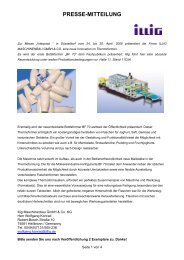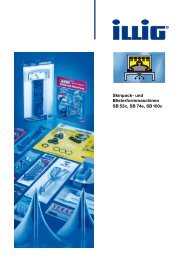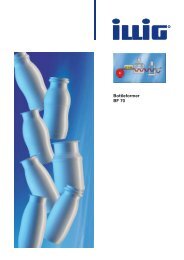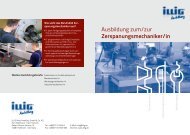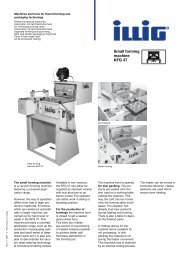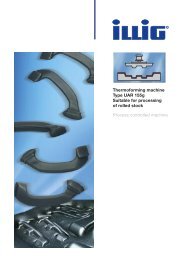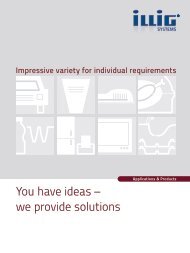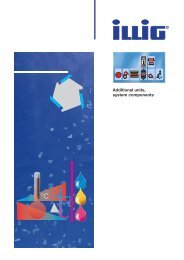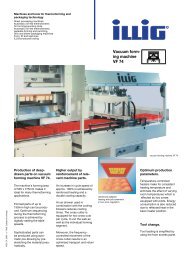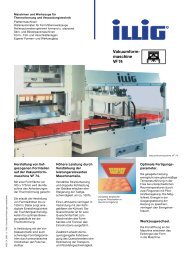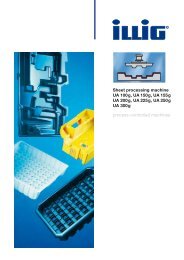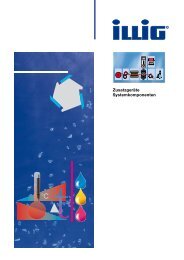Thermoforming - ILLIG Maschinenbau GmbH & Co. KG
Thermoforming - ILLIG Maschinenbau GmbH & Co. KG
Thermoforming - ILLIG Maschinenbau GmbH & Co. KG
You also want an ePaper? Increase the reach of your titles
YUMPU automatically turns print PDFs into web optimized ePapers that Google loves.
KNOW-HOW FOR THERMOFORMERS<br />
Energy efficiency – how can it be compared?<br />
An everyday exampl<br />
In thermoforming, preheating the stock (i.e.,<br />
sheet or film material) at a dedicated station<br />
upstream of the thermoforming machine<br />
is recommended practice. It ensures<br />
a reproducible and uniform stock temperature<br />
at the inlet into the machine’s heating<br />
zone, a superior and more homogeneous<br />
temperature distribution over the entire<br />
process and hence, constant process conditions<br />
which are key to high product quality.<br />
But how does this “extra” heating step affect<br />
the machine’s energy balance?<br />
The table across shows the results of<br />
energy consumption measurements carried<br />
out on a sheet-fed forming machine with<br />
pneumatic and servomotor drives with and<br />
without stock preheating. It emerges that<br />
the specific energy consumption (SEC) of a<br />
machine equipped with stock preheating is<br />
higher in all cases (cf. Fig. 1). The additional<br />
power requirement amounts to approx. 26%<br />
on a pneumatically driven unit, as distinct<br />
from approx. 22% on a servomotor version.<br />
In other words, the additional energy input<br />
per processed kilogram of stock is quite<br />
significant. So does the operator have to<br />
pay “a high price” for the process uniformity<br />
obtained?<br />
It is further evident from the table that<br />
stock preheating yields a significant reduction<br />
in cycle times which translates into<br />
a substantial rise in machine productivity<br />
(PR). On a pneumatically driven machine<br />
this productivity gain exceeds 40%, while<br />
on a servomotor version it may amount<br />
SEC [KWh/kg]<br />
0.35<br />
0.30<br />
0.25<br />
0.20<br />
0.15<br />
0.10<br />
0.05<br />
0.00<br />
1 2 3 4<br />
Machine version<br />
Fig. 1: Specific energy consumption SEC is, by<br />
itself, a parameter of little information value.<br />
Machine version<br />
Cycle time<br />
[s]<br />
to over 50%. It becomes clear at this point<br />
that in thermoforming, specific energy consumption<br />
alone is not the overriding criterion<br />
for assessing energy efficiency.<br />
Objective energy efficiency assessment:<br />
“energy-related productivity“<br />
In order to judge the impact and effectiveness<br />
of a given measure in thermoforming,<br />
the associated specific energy consumption<br />
and the resulting productivity of the<br />
thermoforming machine must always be<br />
viewed in conjunction. It is therefore recommended<br />
to consider machine productivity<br />
as related to specific energy consumption<br />
(PR/SEC) as a reference standard. This<br />
PR<br />
[kg/h]<br />
SEC<br />
[KWh/kg]<br />
PR/SEC<br />
[(kg/h)/(KWh/kg)]<br />
1 UA 155g pneum + BE, without VH 81,2 337 0,237 1 420<br />
2 UA 155g pneum + BE, with VH 57,6 474 0,298 1 592<br />
3 UA 155g servo + BE, without VH 68,4 399 0,193 2 069<br />
4 UA155g servo + BE, with VH 44,8 610 0,235 2 595<br />
Productivity (PR), specific energy consumption (SEC) and energy-related productivity<br />
(PR/SEC) of a sheet-fed thermoforming machine with sheet feeder (BE) and different actuating<br />
systems, determined for 4mm HIPS sheets, without and with stock preheating (VH).<br />
Ensuring energy efficiency – or even a<br />
reduction in energy input – is an economically<br />
rewarding objective in every<br />
value-adding process. But how can<br />
differently equipped thermoformers be<br />
objectively evaluated in terms of their<br />
energy efficiency?<br />
PR/SEC<br />
3000<br />
2500<br />
2000<br />
1500<br />
1000<br />
500<br />
0<br />
1 2 3 4<br />
Machine version<br />
Fig. 2: Energy-related productivity PR/SEC –<br />
a precise and unambiguous indicator.<br />
“energy-related” productivity of a machine<br />
(or of different machine settings) indicates<br />
the productivity achievable by the machine<br />
per kWh/kg of available energy, i.e., it is a<br />
measure of how efficiently the machine can<br />
convert its power input into productivity<br />
(output).<br />
If we apply this principle to the machine<br />
versions examined, a clear picture emerges<br />
(cf. the table and Fig. 2). Stock preheating<br />
yields a substantially higher energy-related<br />
productivity in all cases. The PR/SEC<br />
value rises by approx. 12% for pneumatically<br />
driven machines and by over 25% on<br />
servomotor versions. <strong>Co</strong>nsequently, stock<br />
preheating is not, in energy consumption<br />
terms, a luxury: it definitely pays off because<br />
of the superior “yield” obtained from<br />
the energy expended. The installation of a<br />
stock preheating station can therefore be<br />
recommended unreservedly, since it not<br />
only provides superior process and product<br />
uniformity but also enhances the energy<br />
efficiency of a thermoforming line.<br />
This energy yield situation is graphically<br />
illustrated in Fig. 2. It is therefore expedient<br />
to rely on the energy-related productivity<br />
(PR/SEC) in general whenever the energy<br />
efficiency of a thermoforming machine or<br />
equipment configuration is to be evaluated.<br />
This observation not only holds true for<br />
sheet-fed thermoforming machines – indeed,<br />
energy consumption measurements<br />
on automatic roll-fed systems have confirmed<br />
the rule. Here, too, the PR/SEC value<br />
provides an unambiguous and accurate<br />
measure for assessing different equipment<br />
configurations in terms of their energy efficiency.<br />
14 thermoformer 1/2010



